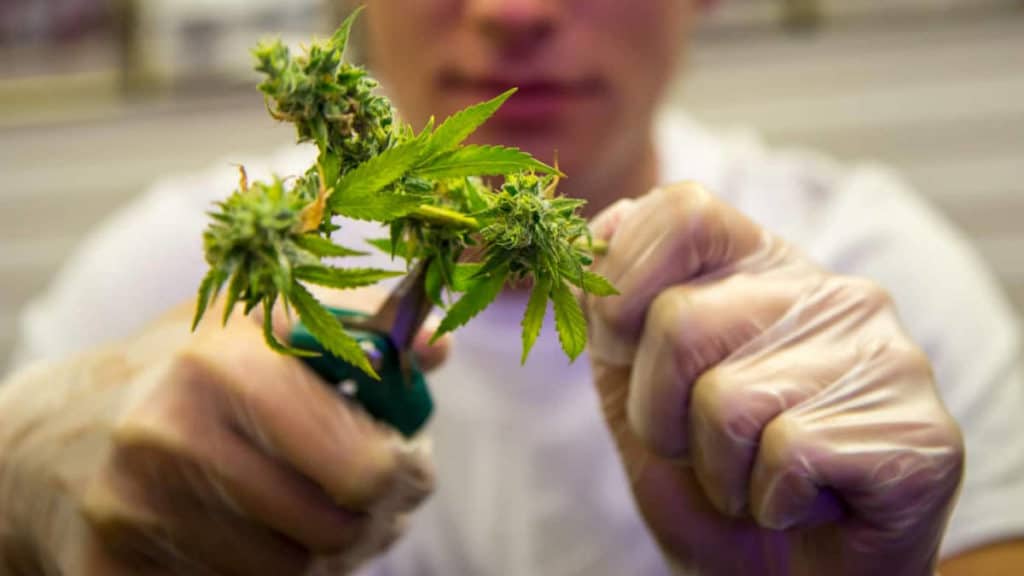
When harvest time rolls around, trimming marijuana is probably not on your mind. With your latest grow op is done, you’re likely thinking it’s time to sit back and relax with a massive joint of home-grown cannabis in hand. Yet there’s still a big job ahead of you: trimming your buds.
It’s not rocket science, but trimming marijuana does come with its challenges. Deciding between wet trimming and dry trimming, choosing the right tools, using the proper trimming techniques, and even just setting aside the time to get the job done isn’t always easy, so use this guide to trimming cannabis buds to help you along the way.
Would you like an ACMPR medical license to grow up to 500 plants at home?
What is the Purpose of Trimming Marijuana?
Before getting into how to trim weed, let’s talk about the “why?” aspect of it all. A lot of growers wonder if it’s even necessary to trim their cannabis plants, and the simple answer is yes.
Appearance
A big reason for the need to trim weed has to do with appearances. You spent all this time watching your plants grow and working around the clock to cultivate quality buds, so the final step is to make it look like quality bud. The top-shelf cannabis at your local dispensary is well-manicured and trimmed, so you should do the same for yours.
Flavours and Aromas
It’s not just about looks, though. Trimming your cannabis can also help to enhance smells and flavours, and we all know how important that is. If you prefer weed that smells strongly of floral, citrusy, piney, or skunky aromas instead of that hay smell you get from untrimmed or poorly trimmed marijuana plants, take the time to trim your buds.
On top of that, the smoke of trimmed buds is less harsh and much smoother than untrimmed cannabis smoke. Leaves smoke a lot harsher than flowers, so doing a quick trim to remove fan leaves and sugar leaves can help to create smoother smoke or vapor.
Cannabinoid Content
If lots of cannabinoids and terpenes are what you’re after, you’re better off enjoying trimmed cannabis. That’s because trimming cannabis can affect the cannabinoid concentration for the better.
You might think that those crystally sugar leaves are jam-packed with THC, but even trichome-covered leaves aren’t nearly as high in cannabinoids (that includes CBD, too) as the bud itself.
Wet Trimming vs. Dry Trimming
The age-old question for trimming marijuana isn’t whether or not the trimming process is necessary (we’ve already established that it 100% is). The real question is do you trim your bud wet, or is it better to trim your cannabis after a lengthy drying time?
Your preferred method of trimming cannabis buds really comes down to weighing the pros and cons of each since there are good and bad to both.
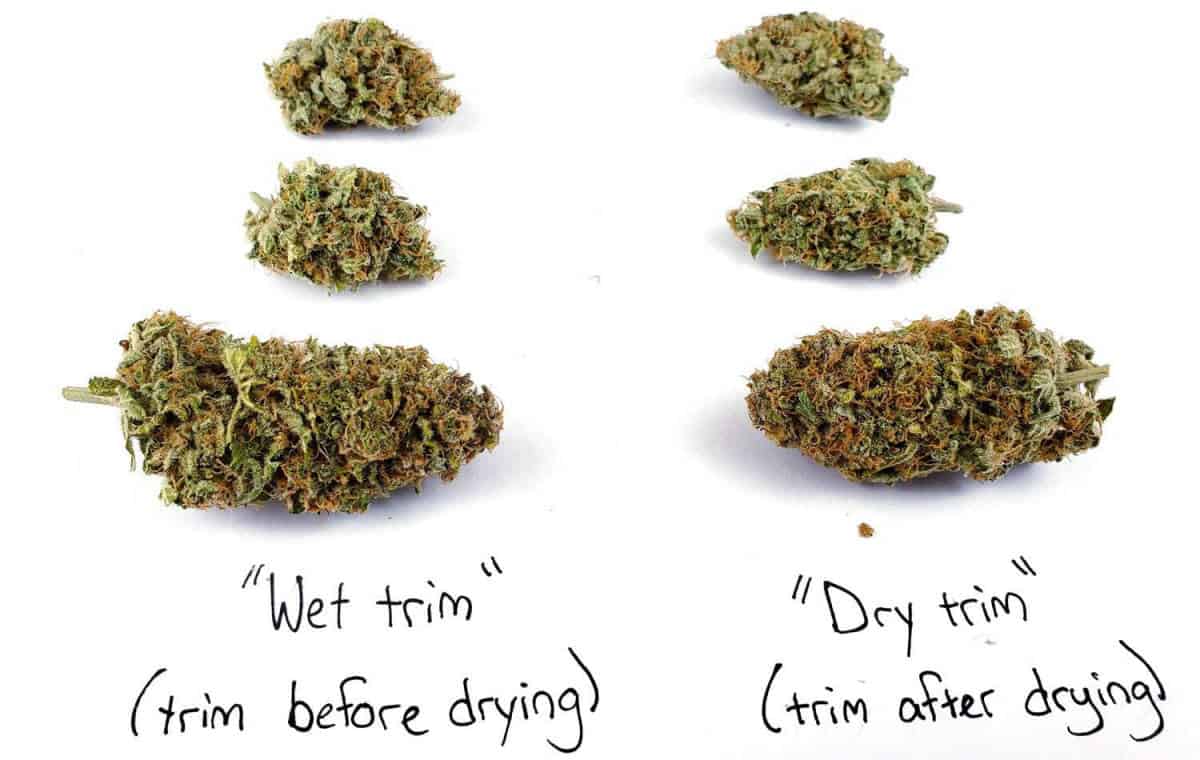
Wet Trimming Cannabis
Wet trimming is when you trim your cannabis before it has been dried. You trim immediately after cutting down a cannabis plant and wait to dry and cure after the trimming process is complete. It’s called “wet trimming” because the bud still holds a lot of moisture, so it literally feels a bit wet as you trim it down.
Trimming marijuana while there’s still moisture makes it much easier to navigate around the bud and remove fan leaves and sugar leaves as you go. It’s very sticky, which is the main con, but this is an easy fix as long as you have easy-to-clean trimmers and rubbing alcohol handy. As you trim, dip the scissors in alcohol every few minutes and wipe them clean with a rag – this will keep them from gumming up.
Trimming wet is a better choice if you’re worried about mold and have high humidity (over 60% RH). It’s also a smarter way to go if you’re tight on space; cutting away all the extra stuff before drying means that you get rid of a lot of unnecessary volume, freeing up space for hanging or laying out the cannabis buds to dry.
Dry Trimming Cannabis
Dry trimming is when you wait to do your trimming after the plants have been dried. So you’ll cut down the stalks, hang them in the drying room or lay them on a drying rack/screen, and trim once the buds have reached their optional moisture level, which usually takes 10 days to two weeks depending on air humidity and bud density.
Dry trim is less sticky, but it’s actually more difficult and more tedious since the leaves have dried and curled back into the buds at this point. To avoid cutting away too much bud, try using a technique where you pull the large fan leaves off first then use a skimming motion with the scissors.
You won’t get the same tidy, manicured look with dry trimming as you will with wet trimming, but there are a few reasons why growers opt to dry trim the final product.
As long as you’re not worried about mold and have low humidity below 45% RH, dry trimming allows the buds to dry more slowly, which prevents that hay smell growers want to avoid. Trimming dry promotes tighter, denser buds, but they’ll sadly lose that vibrant green/purple color compared to wet trim.
How to Trim Cannabis by Hand
For how to trim cannabis, you have a couple of options. The one that many growers opt for is to trim by hand, especially those with a small grow op. Commercial level growers don’t want to spend their entire lives trimming bud, so they often opt for industrial weed trimming machines instead.
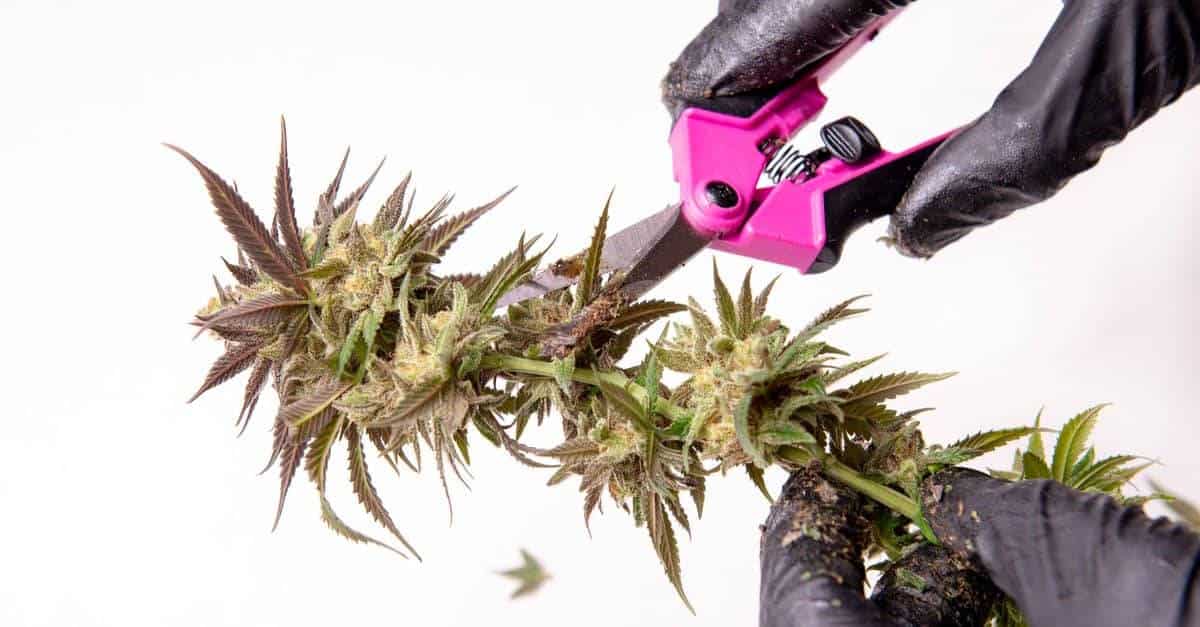
Pros and Cons of Trimming Marijuana by Hand
Just as there are pros and cons to wet and dry trimming, the same goes for hand trimming vs machine trimming. Hand trimming your buds results in the highest quality and the best overall look. Since you have complete control over the bud as you trim down the leaves and extra plant matter, hand trimming usually results in the highest yield.
The biggest drawback of pruning and trimming by hand is the time it takes. Depending on how many plants you have, you might have to pass the time trimming for hours every day before moving on to the curing process (and the drying process if you’ve chosen to wet trim).
When it comes down to it, hand-trimmed marijuana is the nicest to look at – it’s the easiest way to inspect the bud for seeds, stems, and crow s feet as well as more serious issues like mold or insects. You’ll just need to have a bit of patience as you do it.
Marijuana Hand Trimming Steps
When it comes to trimming by hand, the first step is to buy the right tools. You’ll definitely need a quality pair of scissors (a few pairs is even better), but also have some rubbing alcohol and an old rag to keep the shears clean.
Aside from that, make sure you have a comfortable place to sit, a good pair of gloves, a clean flat surface, plenty of light, and some music/TV/podcasts in the background. You might be sitting here for hours, so make the time pass by faster with the right entertainment.
Once you’re all set and ready to go, it’s time to get your first plant and trim your buds. After removing buds from the branches, start by removing the fan leaves (you can do this with your gloved hands) and then use the tips of the scissors to trim away the sugar leaves (these are the small leaves that are growing directly out of the buds).
Whatever you do, be sure to save your trim to use later on. Trimmed leaves don’t have as much THC or CBD, but there’s still some there, so this the perfect plant material for making hash and edibles.
Cannabis Trimming Tips
No matter how time-consuming and tedious your find cannabis trimming, there’s a lot that you can do to make it so much easier. It’s all about using the right techniques, like these:
- When clipping, hold the bud with the stem at the bottom towards your body and rotate it while shearing from bottom to top. Visualize a holiday tree and finish by clipping the end of the stem as close to the flower as you can get.
- Swap scissors often to prevent them from gumming up. Leave one pair soaking in alcohol while using the other.
- Big buds can sometimes hide botrytis or mold, so keep an eye out for grey or brown spots that disintegrate under light blade pressure. This is a sign that the bud is no good.
- Create an efficient workflow. This is a repetitive job and time-wasting movements add up.
- Indica strains generally trim better than sativas, so consider this when choosing your next strains.
- Quality grow conditions (especially during the flowering stage) yield quality, tight buds, so don’t underestimate the power of a good growing environment.
- Consider using carbon filters while your trim cannabis – this is when cannabis smells the most powerful.
Get started on your medical grow license today!
Step 1: Enter your email to book your ACMPR license appointment today
- Compassionate Practitioners Required
- Help with Approvals
- Low Cost Renewals
- No Stress Appointments
Cannabis Trimming Scissors
The best thing you can do to make the trimming process easier is to invest in a quality pair of scissors. Fiskars are the most widely used and longest-lasting scissors, so we suggest going with the Fiskars Non-Stick Softgrip Micro-Tip Pruning Snip.
Fiskars Micro-Tip Pruning Snip
Most Popular Trimming Scissors
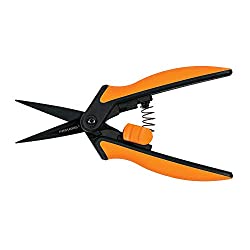
Fiskars are great for really getting in there, but it’s also a good idea to have a sturdy pair of spring-loaded shears on hand, like the Gonicc 8″ Professional Sharp Bypass Pruning Shears. These are perfect for cutting through thicker plant matter, like branches and stems.
Gonicc Professional Bypass Pruning Shears
Pro Shears
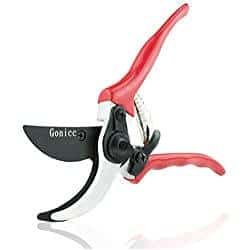
Regardless of the scissors or pruning shears you use, make sure to wear a good pair of gloves, like these Powder-Free Disposable Vinyl Gloves. Gloves will keep your hands resin-free, so wear them always and change them often. If you’re completely against wearing gloves while trimming marijuana, you may want to rub coconut/olive oil on your hands to keep the resin from building up.
Powder-Free Vinyl Gloves
Protective Gloves

Cannabis Drying Rack
Whether you choose to dry before or after the trimming process is 100% your call, but no matter when you do it, the drying process is extremely important. Proper drying allows the cannabinoids and terpenes to stay intact, and curing/trimming at the best time is crucial if quality is what you’re after.
There’s no set time for drying since it depends on the relative humidity of the room, the moisture contained within the buds, and the density of the buds. It can take anywhere from 4 days to 14 days, and it’s usually a lot faster if you’ve opted for wet trimmed buds.
As the buds are drying, keep them in a dark, cool place. Ideally, the temperature should be kept within the 60-70°F range and humidity between 45-55%, and make sure to have a small fan gently circulating the air. The tell-tale sign of dried cannabis buds is when the flowers feel slightly crunchy on the outside and the smallest branches snap instead of fold when you bend them.
It’s also really important that you keep the buds evenly spaced out and not piled on top of each other. Using a drying rack like the XL Herb Drying Rack can help with this.
Anzerwin Drying Rack
Collapsible Drying Rack
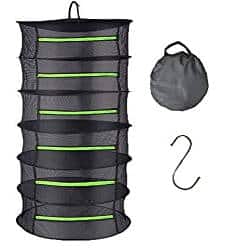
Trim Bin for Cannabis (Every Grower NEEDS This)
A trim bin is one of the greatest investments for anyone who plans on trimming by hand. It’s a bin that’s designed to make trimming easier and more comfortable. The best ones comfortably rest in your lap and let you sit relaxed at a table, in a chair, on the couch, or wherever works best for you.
Most growers recommend using the TrimBin Harvest More Trim Bin, and not just because it’s comfortable to use. The layout is designed with a built-in, ultra-fine 150-micron stainless steel mesh sieve screen to catch all the extra kief, so literally, nothing goes to waste as you trim your buds.
TrimBin Harvest More Trim Bin
Catch More Trim Bin
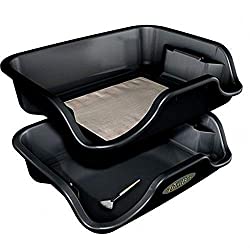
Bowl Trimmers for Cannabis
Marijuana bowl trimmers are a great tool if you’re not loving the idea of trimming everything by hand, but you also don’t need to go as far as buy an automatic trimming machine.
Trimmer bowls have a hand crank, so you still need to use some mechanical motion, but as you spin the crank, the untrimmed bud spins through a lidded bowl as it passes over dozens of sharp blades. These blades work to cut down branches, fan leaves, and sugar leaves while manicuring the buds nicely.
Pros and Cons of Bowl Trimmers
The biggest pro of using a bowl trimming machine is that you won’t have to spend nearly as much as you would with an automatic trimmer. They’re still more expensive than hand trimmers like spring-loaded Fiskars, but a quality bowl won’t break the bank and it will definitely make your life a lot easier, at least in terms of trimming marijuana.
There are a few small downsides to bowl trimming, though. The first is that you’ll probably lose some good trichomes. You won’t be able to give the same attention to detail as you would with trimming buds by hand, so it’s definitely recommended that you use all the trichome-covered leftovers for other projects, like edibles and hash.
Manual Bowl Trimmer for Cannabis
One of the top marijuana trimming tools is the iPower 19-Inch Leaf Bowl Trimmer. It has a large 19-inch diameter, perfect for handling lots of buds at once. It offers the power of 30 pairs of scissors, and all you have to do to harness that power is place the untrimmed buds in the bowl and start turning the crank.
iPower Leaf Bowl Trimmer
#1 Choice for Manual Bowl Trimmer
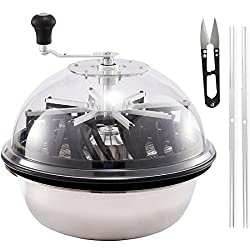
Automatic Bud Trimming Machine
Commercial growers and even larger scale ACMPR growers often turn to an automatic bud trimming machine to help lessen the pain and tediousness that comes along with trim sessions. There are a few types of auto machines to choose from, like a small handheld motorized trimmer that costs hundreds and a full-size machine that costs thousands.
A full-size machine is the best solution if you’re dealing with large quantities and don’t have the time or manpower to trim by hand. After you’ve cut down each plant, you’ll feed the buds through the machine and they’ll be trimmed as they pass through a fast-moving tumbler lined with blades.
The buds will appear out the other end of the tumbler looking so fresh and so clean. Some auto machines are designed to handle both wet and dry trim, and some even have a separate compartment for collecting leftover kief.
Pros and Cons of Automatic Trimmers
Buying an automatic cannabis trimmer might seem like a silly investment, and for some growers, it is. Whether or not paying the high cost is worth it really comes down to how many plants you grow and how much bud you have to trim before moving on to the curing process.
There’s literally not enough time in the day for some large-scale growers to trim their cannabis plants, and this is when an automatic trimming machine comes into play and is a wise investment.
The average time to trim a plant will be slashed way down, but just know that some auto trimmer machines can be rough on the buds, so you could end up cutting away some good trichome-covered sugar leaves.
Bud Trimming Machine
If you’re in the market for a trimmer, check out the Hydroponic 18-inch Motorized Standing Trimmer. It may seem pricy, but you’ll be able to save tons of time in the long run.
It’s still suggested that you go through and remove the larger fan leaves by hand before running buds through a trimming machine, but the machine should be able to take care of the small sugar leaves.
Hydroponic Motorized Trimmer
Reliable Trimming Machine
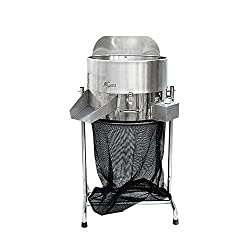
What Is Bucking?
Bucking is the process of removing the flowers and leaves from the stalk of a plant, and this can either be done by hand or with an automated machine. Bucking comes before you trim, and it’s basically just the process of removing all the buds from plant branches to get the next job done more efficiently.
Simplest Bud Remover
Even bucking can take a while, and it can be very tedious without the right tools. As long as it’s the right time, it’s possible to buck buds while the plant is still in the pot, and this can be done with a debudding tool.
Any grower who is all about simplicity will love the DeBudder Bucket Lid from the 420 brand. It works by lining up the branches and stems in the separate channels starting from the bottom and then sliding the debudder upwards to remove all the buds in one clean sweep.
DeBudder Bucket Lid
Simplest Bud Remover
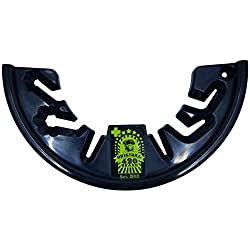
What to Do with Trim
After you’ve spent long hours perfectly manicuring your buds to look like that top-shelf dispensary stuff, you’re left with a massive bag of plant trim. This isn’t nearly as valuable as the buds themselves, but there’s definitely still some value in all the extra kief.
While most of the large leaves can be thrown away, you’ll definitely want to hold on to the rest of the trim. You can use this to make cannabutter, dry ice hash, canna capsules, and even homemade Rick Simpson Oil (RSO).
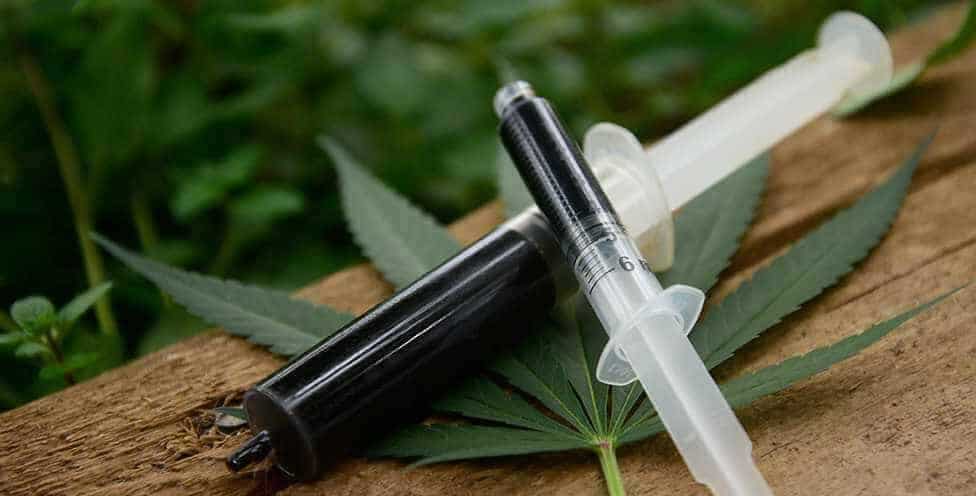
Conclusion
Even if your trim sessions are way down the road and your plants still have some growing to do, it’s still an important thing to think about. Decide early on whether you’ll trim wet or dry and whether you plan to hand trim with scissors, use a machine, or invest in another tool like a bowl trimmer or a bud remover.

Reader Interactions